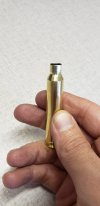bigedp51
Well-Known Member
- Joined
- Dec 10, 2010
- Messages
- 1,022
Vandy321
Bushing dies work best with custom tight neck chambers where the neck doesn't expand as much as a factory SAAMI chamber.
If you have a standard off the shelf factory rifle and turn your necks they will expanded even more and need to be sized back down. Meaning it will work the necks more than unturned brass.
If I turn my necks I only skim turn the necks 50% to 75% to remove the thicker sections.
Bottom line, and adding to what Warbird2006 said above. More people use the Lee collet die because they do not need to turn the necks and have less neck runout than using bushing dies.
The Redding bushing FAQ tells you when you reduce the neck diameter .004 or more you will induce neck runout. And they recommend reducing the neck diameter in two steps to reduce the neck runout. It also states that if the neck thickness varies over .002 to use the expander that comes with the Redding dies. So again bushing dies work best with custom tight neck chambers with neck turned brass.
Bushing dies can induce neck runout the more the neck diameter is reduced, and turning the necks let the neck expand more. And my advice is if you do neck turn with a factory chamber is to only skim turn the necks.
Below is a image of a Redding bushing die, look at the sides of the bushing and the clearance between the bushing and die body. This clearance allows the bushing to move from side to side and even tilt when reducing the neck diameter. Also if you look at the area of the red arrow below this area is not sized. And I believe this is to prevent sizing the area that donuts form.

Reloaders Corner: Outside Case Neck Turning by Glen D. Zediker
http://www.mssblog.com/2017/02/03/reloaders-corner-outside-case-neck-turning/
Here's how my cases look after neck turning. A little splotchy, but my goal is not a universal reduction of wall thickness, just "better is better." So instead of a case being over 0.001 out of spec, now it's about 0.0005 variation, but decidedly not perfect. Those with the smallest visible cut area were better from the start. I do this way mostly to preserve the sizing die dimensions and effect the same on all my brass. Thinner neck walls tend to crack easier, so it's safe enough to say that, with a standard-type rifle chamber (not done with a "tight-necked" Benchrest-style reamer) case life will shorten. Notice the shoulder cut. Removing a little material from this area alleviates case neck donuts.

Bushing dies work best with custom tight neck chambers where the neck doesn't expand as much as a factory SAAMI chamber.
If you have a standard off the shelf factory rifle and turn your necks they will expanded even more and need to be sized back down. Meaning it will work the necks more than unturned brass.
If I turn my necks I only skim turn the necks 50% to 75% to remove the thicker sections.
Bottom line, and adding to what Warbird2006 said above. More people use the Lee collet die because they do not need to turn the necks and have less neck runout than using bushing dies.
The Redding bushing FAQ tells you when you reduce the neck diameter .004 or more you will induce neck runout. And they recommend reducing the neck diameter in two steps to reduce the neck runout. It also states that if the neck thickness varies over .002 to use the expander that comes with the Redding dies. So again bushing dies work best with custom tight neck chambers with neck turned brass.
Bushing dies can induce neck runout the more the neck diameter is reduced, and turning the necks let the neck expand more. And my advice is if you do neck turn with a factory chamber is to only skim turn the necks.
Below is a image of a Redding bushing die, look at the sides of the bushing and the clearance between the bushing and die body. This clearance allows the bushing to move from side to side and even tilt when reducing the neck diameter. Also if you look at the area of the red arrow below this area is not sized. And I believe this is to prevent sizing the area that donuts form.

Reloaders Corner: Outside Case Neck Turning by Glen D. Zediker
http://www.mssblog.com/2017/02/03/reloaders-corner-outside-case-neck-turning/
Here's how my cases look after neck turning. A little splotchy, but my goal is not a universal reduction of wall thickness, just "better is better." So instead of a case being over 0.001 out of spec, now it's about 0.0005 variation, but decidedly not perfect. Those with the smallest visible cut area were better from the start. I do this way mostly to preserve the sizing die dimensions and effect the same on all my brass. Thinner neck walls tend to crack easier, so it's safe enough to say that, with a standard-type rifle chamber (not done with a "tight-necked" Benchrest-style reamer) case life will shorten. Notice the shoulder cut. Removing a little material from this area alleviates case neck donuts.




